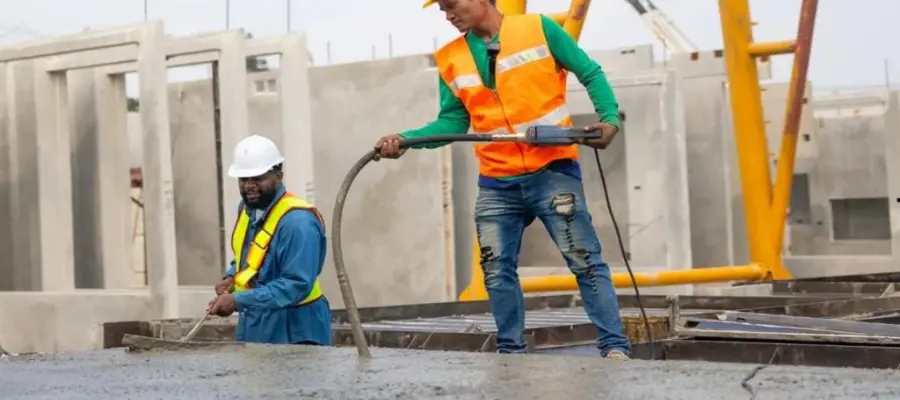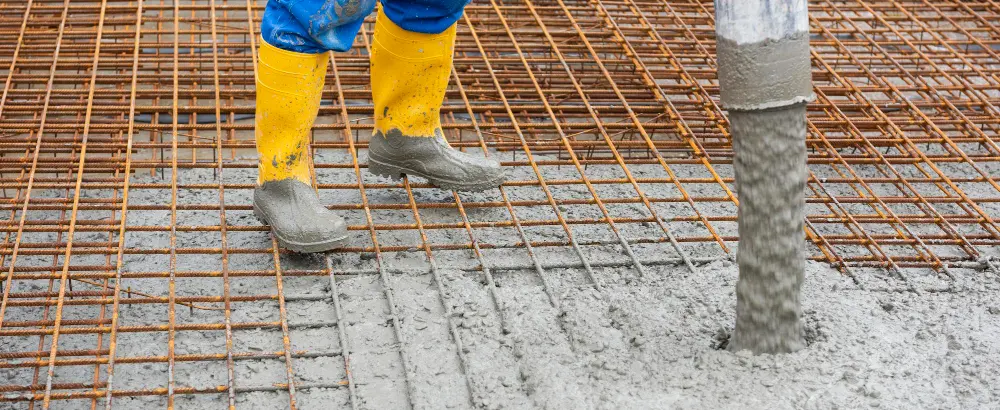Concrete is a versatile material, and it can be poured into a mould to give it a desired shape. However, sometimes, it is difficult to pour concrete into very thin or narrow sections. Hence, self-compacting concrete has come into the construction industry. Self-compacting concrete, or SCC, is the type of concrete that flows under its own weight and does not require vibration from the outside to become compacted. Self-compacting concrete has the characteristics of segregation resistance, filling and passing ability. In their fresh state, SCC exhibits exceptional flow ability, enabling self-compaction and material consolidation without any problems with segregation.
In this blog, let’s explore all the basic details of self-compacting concrete or self-consolidating concrete, including its ingredients, properties, applications, advantages and disadvantages.
What is Self-Compacting Concrete?
Self-compacting concrete (SCC) also referred to as self-consolidating concrete and high-performance concrete, is one of the most popular types of concrete. As mentioned above, self-compacting concrete shows excellent flow ability in its liquid or fresh state, resulting in material consolidation and self-compaction without causing any segregation issues. It’s a type of non-segregating concrete that can fill in formwork and conceal deeply recessed, narrow, and heavily reinforced areas with its weight.
Self-compacting concrete compacts without the need for outside force or vibration, in contrast to conventional concrete, which uses mechanical tools like immersion vibrators. Self-compacting concrete is used in situations where vibrators are unable to consolidate concrete.
Admixtures like superplasticisers and viscosity modifiers are used in some self-consolidating concrete mixtures to reduce bleeding and segregation. Segregation reduces the strength of the concrete, leaving areas of the surface with honeycomb patterns. On the other hand, properly designed self-compacting concrete will not separate because of its stability and flexibility.
Types of Ingredients Used in Self-Consolidating Concrete
The following are the core ingredients of the SCC.
- Cement
The OPC – ordinary Portland cement of grade 43 or 53 is used to make SCC.
- Aggregates
Aggregate sizes used in SCC design are restricted to 20 mm, and round or cubic well-graded aggregates are the best option. Aggregate sizes in the range of 10 to 12 mm may be utilised if the reinforcement used for the structure is crowded. Fine aggregates with a particle size of less than 0.125 mm are typically used. Both manufactured sand (M-Sand) and natural aggregates with a uniform grade can be used as fine aggregates in SCC.
- Water
Clean and potable water is used to make self-compacting concrete.
- Mineral Admixtures
Admixtures are materials that can modify the properties of concrete in its fresh or hardened state. There are two types of admixtures available in the market: mineral admixtures and chemical admixtures to make.
The following are the different mineral admixtures that may be used depending on the mix design and required properties of SCC.
- Fly ash: The fly ash particles are very fine hence, they help to enhance the filling of the internal voids of the concrete matrix. It increases the durability and quality of the SCC structures.
- Ground Granulated Blast Furnace Slag (GGBS): GGBS helps to enhance the rheological properties of the SCC.
- Silica Fumes: Using silica fumes helps improve the mechanical properties of the SCC structure.
- Stone Powder: Stone powder is used in SCC to increase the powder content of the mix.
- Chemical Admixtures
Chemical admixtures like superplasticizers, retarders, and air-entraining admixtures are also frequently used in the design of SCC mixes. Superplasticisers reduce the water requirement in the mix and increase workability. Air-entraining agents increase the concrete structure’s resistance to freezing and thawing. Retarders are used to regulate the setting time of the fresh concrete.
Properties of Self-Compacting Concrete

In its fresh state, the properties of the self-compacting concrete meet its requirements. The following are the properties of SCC.
- Filling Ability
The ability of concrete to flow under its own weight without any intentional vibration is one of its properties.
- Passing Ability
The ability of the concrete to retain its homogeneity.
- Segregation Resistance
This is the resistance of concrete to segregating as it flows during the process of self-compaction.
Applications of Self-Compacting Concrete
The following are the major uses of self-consolidating concrete:
- High-performance concrete is used in the construction of structures with complex reinforcement arrangements.
- It’s used in the construction of retaining walls that are incredibly sturdy and stable.
- It’s used in the construction of pile foundations and rafts.
- It’s used in the construction for repair, restoration and renewal.
Advantages of Self-Compacting Concrete
The following are the benefits of self-compacting concrete:
- The construction of self-compacting concrete structures is faster than that of normal concrete structures.
- It reduces the permeability of the concrete structure.
- SSC can be easily poured into narrow and thin sections of the structure, enabling the freedom of design.
- The SCC construction is faster.
- Compared to the traditional concrete structure, the reliability and durability of the SSC structure are high.
- As SCC does not require compaction, it eliminates the issues regarding vibration.
- The overall construction quality is improved.
- The placement of the SCC is easy, so it reduces labour costs, resulting in cost savings.
Disadvantages of Self-Compacting Concrete
The following are the disadvantages of SCC construction:
- The construction cost of high-performance concrete structures is higher than that of traditional concrete.
- The precise measurement and monitoring required for the SSC construction
- The SCC design mix requires more trial and testing.
- The material selection for self-consolidating concrete is more difficult.
Conclusion
In conclusion, self-compacting concrete is a preferred option in many construction applications because it provides significant advantages in terms of workability, durability, structural integrity, and aesthetics. However, it is essential to remember that the design and manufacturing of this high-performance concrete demand meticulous consideration of the mix proportions, including the choice of appropriate aggregates, chemical admixtures, and cementitious materials. Adequate testing and quality control techniques are crucial for assuring consistency and fulfilling the specific needs of the project.

